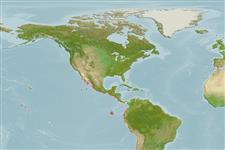Actinopterygii (ray-finned fishes) >
Perciformes (Perch-likes) >
Carangidae (Jacks and pompanos) > Trachinotinae
Etymology: Trachinotus: Greek, trachys, -eia, -ys = rough + Greek,noton = back (Ref. 45335).
Environment / Climate / Range
Ecology
Marine; pelagic-neritic; depth range 0 - 6 m (Ref. 5227). Tropical, preferred ?
Eastern Pacific: Ecuador and Peru, including the Revillagigedo and Galapagos islands.
Size / Weight / Age
Maturity: Lm ? range ? - ? cm
Max length : 34.0 cm FL male/unsexed; (Ref. 9283); common length : 30.0 cm FL male/unsexed; (Ref. 9283)
Adults are found near islands (Ref. 9283). They generally form big schools (Ref. 9283). Not directly targeted for fishing (Ref. 9283).
Life cycle and mating behavior
Maturity | Reproduction | Spawning | Eggs | Fecundity | Larvae
Smith-Vaniz, W.F., 1995. Carangidae. Jureles, pámpanos, cojinúas, zapateros, cocineros, casabes, macarelas, chicharros, jorobados, medregales, pez pilota. p. 940-986. In W. Fischer, F. Krupp, W. Schneider, C. Sommer, K.E. Carpenter and V. Niem (eds.) Guia FAO para Identification de Especies para lo Fines de la Pesca. Pacifico Centro-Oriental. 3 Vols. FAO, Rome. (Ref. 9283)
IUCN Red List Status (Ref. 115185)
CITES (Ref. 94142)
Not Evaluated
Threat to humans
Harmless
Human uses
Fisheries: minor commercial; gamefish: yes
More information
Common namesSynonymsMetabolismPredatorsEcotoxicologyReproductionMaturitySpawningFecundityEggsEgg development
ReferencesAquacultureAquaculture profileStrainsGeneticsAllele frequenciesHeritabilityDiseasesProcessingMass conversion
Tools
Special reports
Download XML
Internet sources
